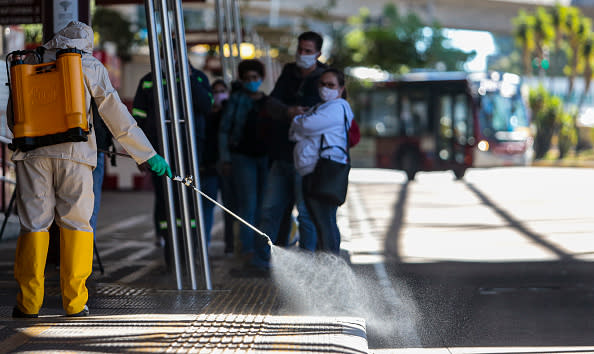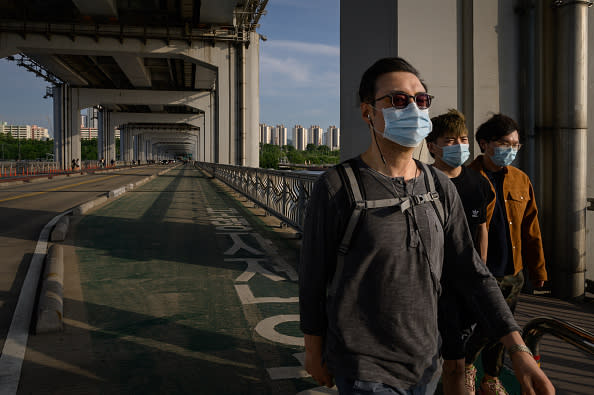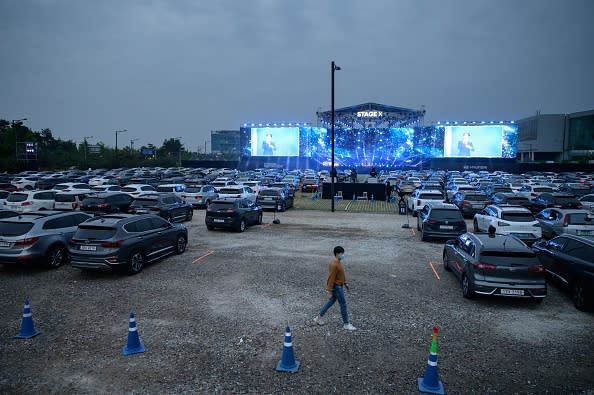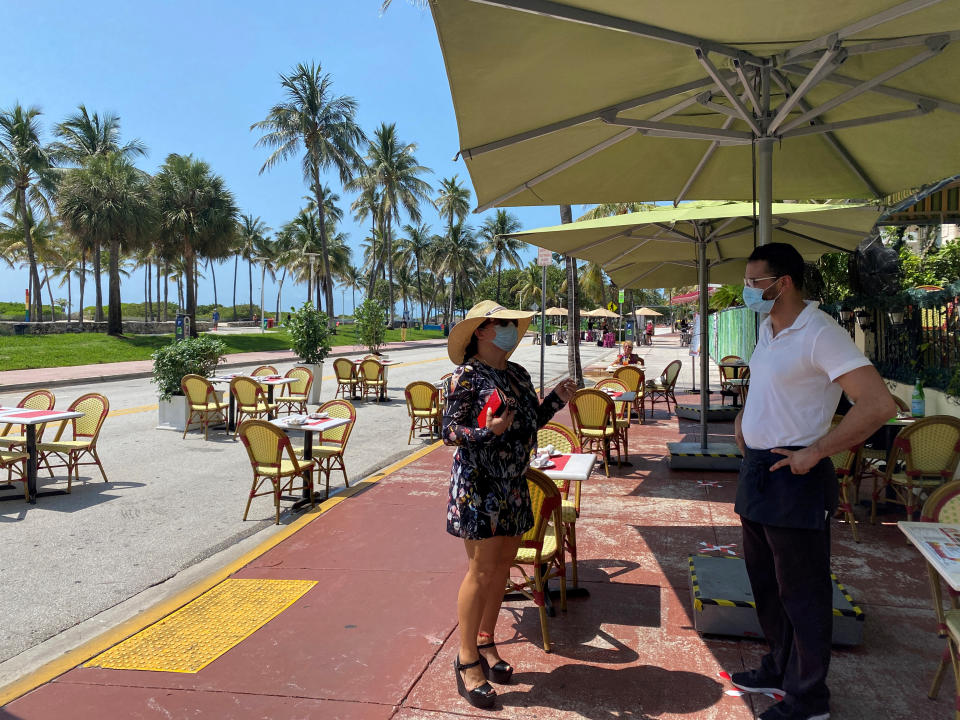Epicentre's shocking decision moments before horrific virus deaths revealed
A number of countries with widespread coronavirus infections are preparing to reopen despite the ongoing risks.
Sao Paulo state, the epicentre of the coronavirus outbreak in Brazil and the city with the fastest growing number of confirmed COVID-19 cases, will reopen some of its closed businesses starting June 1.
Governor João Doria said Wednesday that stay-at-home recommendations will remain in effect until June 15 for the state that’s home to 46 million people, but some economic activity will resume in regions where daily increase in cases are slow and enough intensive-care beds are available.

After Mr Doria’s announcement, Sao Paulo state confirmed 289 deaths in the last 24 hours, the second biggest daily figure on record. The highest was 324 fatalities registered on May 19.
The businesses allowed to reopen initially under a five-step plan are stores, shopping malls, offices, car dealerships and real estate brokerages. Social distancing and masks will still be necessary.
More than 6,700 people have died because of the novel coronavirus in Sao Paulo state, about one fourth of all Brazil’s deaths. The state also confirmed almost 90,000 COVID-19 cases, while Brazil has more than 400,000.
Mr Doria has been frequently singled out for criticism by Brazil’s President Jair Bolsonaro, who has opposed the governors’ restrictions on activity and urged his supporters to resume normal life.
'A laughing stock': Outrage as hundreds ignore lockdown to attend pool party
First state to lock down emerges as one of nation's worst hotspots
Man dies in custody after video shows police crushing his neck
The move in Sao Paulo is a sign of Brazil’s ambivalence over whether to open up or impose stricter a lockdown. Several cities in the country’s impoverished Northeast region are also planning to reopen after using more restrictive measures.

Only two weeks ago, Doria said he was considering a lockdown to stop the spread, a measure that many analysts deemed to be key to stop the virus. On Monday he said it was no longer under consideration. Sao Paulo has kept nonessential industries and civil construction open.
“It is a conscious restart of some activities in Sao Paulo state,” the governor said in a press conference alongside members of his anti-coronavirus task force.
He added mayors will have the autonomy to implement the suggested changes or not.
Cities of the Sao Paulo metropolitan area and coast, where contagion is still high, are not yet in a position to begin reopening, the governor said.
Any change to phase two will only be allowed if a region or a city sees stable figures for 14 days, Mr Doria said.
Phase two would allow a restart for bars and restaurants and beauty salons.

South Korea reopens despite nightclub cluster
As South Korea significantly relaxes its rigid social distancing rules as a result of waning coronavirus cases, the world is paying close attention to whether it can return to something that resembles normal - or face a virus resurgence.
South Korea currently has more than 11,000 cases and 260 deaths, according to Johns Hopkins University.
Already, a mini-outbreak linked to nightclubs in Seoul has tested South Korea’s widely praised method for dealing with the disease – essentially a combination of rapid tracing, testing and treatment, along with stringent social distancing practices.
“Other countries must be wondering whether our nation will continue to make good progress,” Jin Yong Kim said, a doctor at Incheon Medical Center near Seoul who confirmed South Korea’s first patient on January 20 and has since treated more than 100 others.
“But I can’t predict with authority what will happen here from now on.”

South Korea once had the world’s largest number of coronavirus cases outside mainland China, but its daily caseload has since dropped to around 10-30 and occasionally has hit single digits in recent weeks. South Korea on Wednesday still reported 40 new cases, its biggest daily jump in about 50 days.
The recent uptick in fresh infections linked to nightclubs in Seoul’s Itaewon entertainment district has raised fears of another big outbreak.
Since the first patient was associated with the nightclubs on May 6 - the same day the social distancing policy was officially eased - South Korea has confirmed more than 250 related cases.
It’s unclear how things will play out, but so far the outbreak hasn’t grown, unlike what happened in late February and early March when hundreds of new patients were reported each day, many of them tied to a controversial church gathering in the country’s southeast.
The tried and tested methods of aggressive tracing, testing and treatment and the widespread public use of masks again played a major role in preventing the outbreak in Itaewon from exploding, Hyukmin Lee, a professor at Yonsei University of College of Medicine in Seoul, said.

US deaths exceed 100,000
US deaths from the novel coronavirus topped 100,000 on Wednesday even as the daily average death toll declines, businesses reopen and Americans emerge from lockdowns across the country.
About 1,400 Americans have died on average each day in May, down from the peak of the outbreak in April when 2,000 people a day died on average.
But that hasn’t stopped Florida’s businesses reopening.
Miami Beach, perched on a series of coastal islands across Biscayne Bay from Miami proper, is part of a metropolitan region that is among the last in the United States to begin emerging from the months-long lockdown.
The partial opening comes after the Memorial Day holiday weekend, usually one of the city's busiest and most raucous weekends of the year. By waiting, officials hoped to stave off crowds like those who flocked to beaches during college spring break in mid-March, when the number of COVID-19 cases began multiplying.
Jennifer DeMarchi, who spends winters in Miami and runs a networking group for marketing professionals, was eager to get out and enjoy an early meal. She and her husband John had spent the last few days bouncing between various south Florida cities as beaches and restaurants slowly reopened.

"If the crowds become too large or the numbers start to go back up, of course we'll go back inside, of course," she said.
"We've been here for four months and most of it we've been stuck in an apartment, we had to get out."
South Florida's Miami-Dade, Broward, and Palm Beach counties have reported more COVID-19 cases than any of the state's 67 counties. As of Wednesday, Miami-Dade County had confirmed over 17,000 cases of COVID-19 and 655 deaths, according to the state health department.
The popularity of Miami Beach as a destination for Americans and international travellers pushed city leaders to pursue the slow opening. The loss of revenue under the lockdown from taxes and other fees amounts to about $3.5 million each week, according to Mayor Dan Gelber.
Restaurants can open now under certain restrictions, which include changing air conditioning filters, lengthy staff training, and 50 percent seating capacity.
The city has closed a number of streets to traffic, including Ocean Drive, and is allowing restaurants to expand their outdoor eating to help make up for some of the lost space. From June 1, beaches and hotels can open.
The US death toll is higher than fatalities from the seasonal flu going back to the 1957-1958 season, when 116,000 died. In about three months, COVID-19 deaths exceed the number of Americans killed in the Korean War, Vietnam War and the U.S. conflict in Iraq from 2003-2011 - combined.
The coronavirus has killed more people than the AIDS epidemic did from 1981 through 1989.
Total US coronavirus cases are over 1.7 million with some southern states seeing new cases rising in the past week, according to a Reuters analysis of data from The COVID Tracking Project, a volunteer-run effort to track the outbreak.
with The Associated Press and Reuters
Do you have a story tip? Email: newsroomau@yahoonews.com.
You can also follow us on Facebook, Instagram and Twitter and download the Yahoo News app from the App Store or Google Play.




